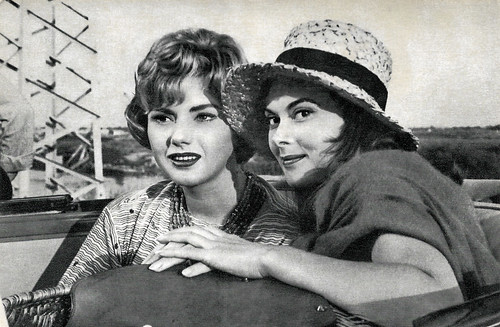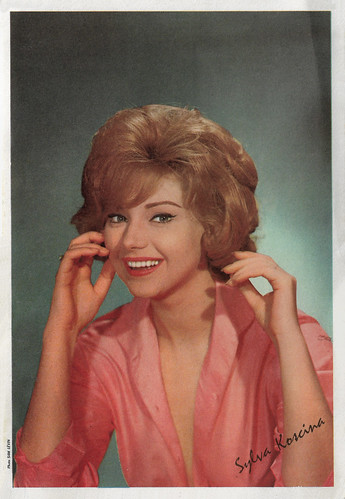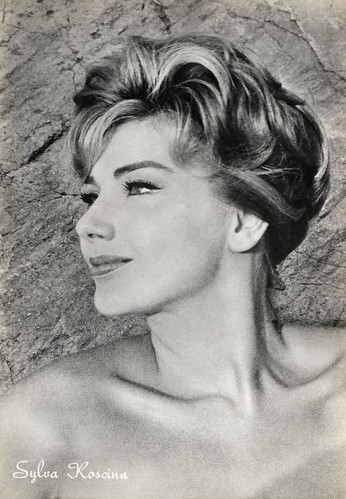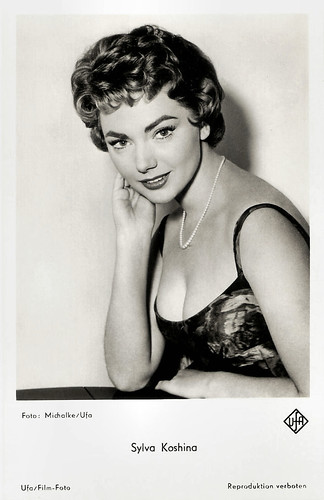Italian, Yugoslav-born actress Sylva Koscina (1933-1994) may be best remembered as Iole, the bride of Steve Reeves in the original version of Hercules (1958). She also starred in several Italian and Hollywood comedies of the 1950s and 1960s.

Italian postcard by Rotalcolor, no. 20.

Italian postcard by Rotalfoto, Milano, no. 64.

Small Romanian collector card. Sylva Koscina and Steve Reeves in Ercole e la regina di Lidia/Hercules Unchained (Pietro Francisci, 1959).

French postcard by Editions du Globe, Paris, no. 28. Photo: Sam Lévin.

Spanish postcard by Postal Oscarcolor, Hospitalet (Barcelona), no. 109, 1964.
Sylva Koscina was born Sylva Koskinon in Zagreb, Kingdom of Yugoslavia (now Croatia), in 1933. As a teenager, she moved to Italy during the Second World War. She was a physics student at Naples University.
In 1954, she was chosen as Miss Di Tappa at the Giro d’Italia (Tour of Italy bicycle race). A picture of her exchanging a kiss with the winner was published in newspapers all over Europe and this led to a job as a model. As a fashion model, she was soon discovered for the cinema.
She made a fleeting appearance in the part of an aspiring actress in the Toto comedy Siamo uomini o caporali?/Are We Men or Corporals? (Camillo Mastrocinque, 1955) before she had her breakthrough as the daughter of the train engineer in Il ferroviere/The Railroad Man (Pietro Germi, 1956).
Pretty, even too elegant for the part, Sylva Koscina immediately confirmed her talent in Guendalina (Alberto Lattuada, 1957) as a young mother of Jacqueline Sassard. She played leading roles in popular comedies like Nonna Sabella/Grandmother Sabella (Dino Risi, 1957), Ladro lui, ladra lei/He a Thief She a Thief (Luigi Zampa, 1958), and Poveri millionari/Poor Millionaires (Dino Risi, 1958).
Koscina alternated cleverly between roles as a vamp and as an ingenue. She represented women in the search for social upward mobility, the image of an Italy that had left its worst problems behind.

East-German postcard by VEB Progress Film-Vertrieb, Berlin, no. 1021, 1959. Retail price: 0,20 DM. Photo: G.B. Poletto, Rome. Sylva Koscina in La nonna Sabella/Grandmother Sabella (Dino Risi, 1957).

East German Starfoto by Progress Film-Vertrieb, Berlin, no. 1037, 1959. Photo: G.B. Poletto. Sylva Koscina in La nonna Sabella/Grandmother Sabella (Dino Risi, 1957).

Small Romanian collector card. Sylva Koscina and Steve Reeves in Ercole e la regina di Lidia/Hercules Unchained (Pietro Francisci, 1959).

French postcard by Editions P.I,, no. 934, presented by Les Carbones Korès 'Carboplane'. Photo: Sam Lévin.

Spanish postcard by Archivo Bermejo, no. C-236, 1964. Photo: Universal Films. Sylva Koscina in La cambiale/The Bill of Excange (Camillo Mastrocinque, 1959).

Romanian postcard by Casa Filmului Acin, no. 13. Sylva Koscina and Dorian Gray in Le sorprese dell'amore/Surprise of Love (Luigi Comencini, 1959).

Italian postcard by Bromofoto, Milano, no. 1728. Photo: Cineriz. Sylva Koscina in Il vigile/The Traffic Policeman (Luigi Zampa, 1960). Koscina had a small part in the film as herself.
Sylva Koscina was an actress noted for her carriage. She had an entirely feminine way of walking on the screen and she even lectured Giorgia Moll on how to walk like a lady in the sophisticated comedy Mogli pericolose/Dangerous Wives (Luigi Comencini, 1958).
In many of her roles, she gave the impression of modelling at a fashion show, head high, mouth very slightly open, eyes lost in the distance. She was the elegant actress of the sixties with an aristocratic manner bordering on snobbery.
However she also seemed at ease in a Peplum (sword and sandal epic): she was a marvellous fiancee for Hercules (Steve Reeves) in Le fatiche di Ercole/Hercules (Pietro Francisci, 1958), a prototype of this film genre. In Il vigile/The Policeman (Luigi Zampa, 1960), she played herself opposite Alberto Sordi as a traffic officer.
Charmed by her, he lets Sylva go without a ticket, but when the film star thanks him on TV he gets into a lot of trouble. Koscina married Raimondo Castelli, a small producer connected with Minerva Films. She managed to keep well afloat with roles that were anything but negligible such as a dramatic part in Il sicario/Blood Feud (Damiano Damiani, 1961) with Belinda Lee.
In La lepre e la tartaruga/The Hare and the Tortoise, an episode in Le quattro verità/The Three Fables of Love (Alessandro Blasetti, Hervé Bromberger, René Clair, Luis García Berlanga, 1963), director Alessandro Blasetti constructs a deliciously sophisticated duel between her and Monica Vitti. In 1965 Sylva took part in Giulietta degli spiriti/Juliet of the Spirits (Federico Fellini, 1965) as one of Giulietta Masina's sisters. But she also became a television personality who was often the special guest on variety shows.

French postcard by EDUG, no. 145. Photo: Sam Lévin.

French postcard. Photo: Sam Lévin.

French card. Photo Sam Lévin.

Austrian card by Reclam, Wien. Sylva Koscina in Hot Enough for June (Ralph Thomas, 1964).

British press photo, no. 319/95. Sylva Koscina and David McCallum in Three Bites of the Apple (Alvin Ganzer, 1967).

Romanian postcard by Casa Filmului Acin, no. 109. Retail price: 2 Lei. Photo: publicity still for Deadlier Than the Male (Ralph Thomas, 1967) with Richard Johnson.

Romanian postcard by Casa Filmului Acin, no. 9. Sylva Koscina and Jean Sorel in I Protagonisti/The Protagonists (Marcello Fondato, 1968).
After passing thirty, Sylva Koscina tried playing the American card. She starred in the comedy caper Three Bites of the Apple (Alvin Ganzer, 1967) with David McCallum and Deadlier Than the Male (Ralph Thomas, 1966), in which she and Elke Sommer portrayed sophisticated professional killers duelling with Bulldog Drummond (Richard Johnson).
She partnered with Paul Newman in The Secret War of Harry Frigg (Jack Smight, 1968) and with Kirk Douglas in A Lovely Way to Die (David Lowell Rich, 1968). She appeared as a German doctor, Bianca, in Hornet's Nest (Phil Karlson, Franco Cirino, 1970) with Rock Hudson, but without luck.
Her fame became a bit tarnished, but it was given a boost with her appearance in the Italian edition of Playboy magazine in 1967. The photography by Angelo Frontoni was exquisite, and the fact of a film star photographed bare-breasted in a magazine provoked a scandal.
So, the image of Sylva, based on an elegant and slightly snobbish femininity was enriched with an erotic touch. In that same period, L'assolute naturale/He and She (Mauro Bolognini, 1969) was released complete with a full nude shot. This was a sign of the radical change Italian cinema and society were undergoing.
Some of her lovemaking scenes with Gabriele Tinti in the fantasy film Lisa and the Devil (Mario Bava, Alfredo Leone, 1974) had to be cut because they were considered pornographic.

Italian postcard by Rotalfoto, Milano, no. 888.

Spanish postcard by Archivo Bermejo, no. 10, 1964. Photo: Universal.

Italian postcard by Rotalcolor, no. 297.

Italian postcard by Rotalfoto, Milano, no. 210. Sent by mail in 1977.

Italian postcard by Rotalfoto, Milano, no. 206.

Italian postcard by Rotalfoto, Milano, no. 220.

Belgian postcard by Editions Decker, Brussels, no. P.U. 55.
Since the early 1960s, Sylva Koscina had invested most of her star salaries in a luxurious villa, in the well-to-do district of Marino, Rome, complete with 16th-century furniture and artist's paintings. This lasted until her spending overcame her dwindling income, and in 1976, when she had to face a tax evasion inquest, she was forced to sell her house.
She lived with Raimondo Castelli since 1960, but they could not marry because his wife refused a divorce. In 1967 Raimondo and Sylva married in Mexico, but this marriage was not officially recognised in Italy, and they separated in 1971.
Sylva depended more and more on erotic appearances. In June 1975 she was on the cover and featured again in the Italian Playboy. She appeared in sex comedies like Some Like It Cool (Franz Antel, 1977) with Tony Curtis, and in a segment of Sunday Lovers (Dino Risi, 1980) with Ugo Tognazzi.
In the 1980s Sylva had a long-running live theatre performance in Rome. By then a mature but still beautiful Koscina, performed every night in the nude. She only incidentally appeared in films, including Cenerentola '80/Cinderella ´80 (Roberto Malenotti, 1984) with Adolfo Celi, and Rimini Rimini (Sergio Corbucci, 1987) with Laura Antonelli.
Koscina returned before the cameras in the year just before her death: her last appearance was in the tantalizingly titled C'è Kim Novak al telefono/Kim Novak is on the Phone (Riki Roseo, 1994). After a long battle with breast cancer, Sylva Koscina died in Rome in 1994, aged 61.

West German postcard by Ufa/Film-Foto, Berlin-Tempelhof, no. FK 4194. Photo: Georg Michalke / Ufa.

Vintage postcard by Studio Sombor.

Romanian postcard by Casa Filmului Acin, no. 41. Retail price: 2 Lei.

Romanian postcard by Casa Filmului Acin, no. 217. Retail price: 1,50 Lei.

Romanian postcard by Casa Filmului Acin.

East German Starfoto by Progress Film-Verleih, Berlin, no. 31/76.
Sources: Hal Erickson (AllMovie - Page now defunct), Simon Benattar-Bourgeay (CinéArtistes - French), Glamour Girls of the Silver Screen, Wikipedia and IMDb.

Italian postcard by Rotalcolor, no. 20.

Italian postcard by Rotalfoto, Milano, no. 64.

Small Romanian collector card. Sylva Koscina and Steve Reeves in Ercole e la regina di Lidia/Hercules Unchained (Pietro Francisci, 1959).

French postcard by Editions du Globe, Paris, no. 28. Photo: Sam Lévin.

Spanish postcard by Postal Oscarcolor, Hospitalet (Barcelona), no. 109, 1964.
Miss Di Tappa
Sylva Koscina was born Sylva Koskinon in Zagreb, Kingdom of Yugoslavia (now Croatia), in 1933. As a teenager, she moved to Italy during the Second World War. She was a physics student at Naples University.
In 1954, she was chosen as Miss Di Tappa at the Giro d’Italia (Tour of Italy bicycle race). A picture of her exchanging a kiss with the winner was published in newspapers all over Europe and this led to a job as a model. As a fashion model, she was soon discovered for the cinema.
She made a fleeting appearance in the part of an aspiring actress in the Toto comedy Siamo uomini o caporali?/Are We Men or Corporals? (Camillo Mastrocinque, 1955) before she had her breakthrough as the daughter of the train engineer in Il ferroviere/The Railroad Man (Pietro Germi, 1956).
Pretty, even too elegant for the part, Sylva Koscina immediately confirmed her talent in Guendalina (Alberto Lattuada, 1957) as a young mother of Jacqueline Sassard. She played leading roles in popular comedies like Nonna Sabella/Grandmother Sabella (Dino Risi, 1957), Ladro lui, ladra lei/He a Thief She a Thief (Luigi Zampa, 1958), and Poveri millionari/Poor Millionaires (Dino Risi, 1958).
Koscina alternated cleverly between roles as a vamp and as an ingenue. She represented women in the search for social upward mobility, the image of an Italy that had left its worst problems behind.

East-German postcard by VEB Progress Film-Vertrieb, Berlin, no. 1021, 1959. Retail price: 0,20 DM. Photo: G.B. Poletto, Rome. Sylva Koscina in La nonna Sabella/Grandmother Sabella (Dino Risi, 1957).

East German Starfoto by Progress Film-Vertrieb, Berlin, no. 1037, 1959. Photo: G.B. Poletto. Sylva Koscina in La nonna Sabella/Grandmother Sabella (Dino Risi, 1957).

Small Romanian collector card. Sylva Koscina and Steve Reeves in Ercole e la regina di Lidia/Hercules Unchained (Pietro Francisci, 1959).

French postcard by Editions P.I,, no. 934, presented by Les Carbones Korès 'Carboplane'. Photo: Sam Lévin.

Spanish postcard by Archivo Bermejo, no. C-236, 1964. Photo: Universal Films. Sylva Koscina in La cambiale/The Bill of Excange (Camillo Mastrocinque, 1959).

Romanian postcard by Casa Filmului Acin, no. 13. Sylva Koscina and Dorian Gray in Le sorprese dell'amore/Surprise of Love (Luigi Comencini, 1959).

Italian postcard by Bromofoto, Milano, no. 1728. Photo: Cineriz. Sylva Koscina in Il vigile/The Traffic Policeman (Luigi Zampa, 1960). Koscina had a small part in the film as herself.
Hercules
Sylva Koscina was an actress noted for her carriage. She had an entirely feminine way of walking on the screen and she even lectured Giorgia Moll on how to walk like a lady in the sophisticated comedy Mogli pericolose/Dangerous Wives (Luigi Comencini, 1958).
In many of her roles, she gave the impression of modelling at a fashion show, head high, mouth very slightly open, eyes lost in the distance. She was the elegant actress of the sixties with an aristocratic manner bordering on snobbery.
However she also seemed at ease in a Peplum (sword and sandal epic): she was a marvellous fiancee for Hercules (Steve Reeves) in Le fatiche di Ercole/Hercules (Pietro Francisci, 1958), a prototype of this film genre. In Il vigile/The Policeman (Luigi Zampa, 1960), she played herself opposite Alberto Sordi as a traffic officer.
Charmed by her, he lets Sylva go without a ticket, but when the film star thanks him on TV he gets into a lot of trouble. Koscina married Raimondo Castelli, a small producer connected with Minerva Films. She managed to keep well afloat with roles that were anything but negligible such as a dramatic part in Il sicario/Blood Feud (Damiano Damiani, 1961) with Belinda Lee.
In La lepre e la tartaruga/The Hare and the Tortoise, an episode in Le quattro verità/The Three Fables of Love (Alessandro Blasetti, Hervé Bromberger, René Clair, Luis García Berlanga, 1963), director Alessandro Blasetti constructs a deliciously sophisticated duel between her and Monica Vitti. In 1965 Sylva took part in Giulietta degli spiriti/Juliet of the Spirits (Federico Fellini, 1965) as one of Giulietta Masina's sisters. But she also became a television personality who was often the special guest on variety shows.

French postcard by EDUG, no. 145. Photo: Sam Lévin.

French postcard. Photo: Sam Lévin.

French card. Photo Sam Lévin.

Austrian card by Reclam, Wien. Sylva Koscina in Hot Enough for June (Ralph Thomas, 1964).

British press photo, no. 319/95. Sylva Koscina and David McCallum in Three Bites of the Apple (Alvin Ganzer, 1967).

Romanian postcard by Casa Filmului Acin, no. 109. Retail price: 2 Lei. Photo: publicity still for Deadlier Than the Male (Ralph Thomas, 1967) with Richard Johnson.

Romanian postcard by Casa Filmului Acin, no. 9. Sylva Koscina and Jean Sorel in I Protagonisti/The Protagonists (Marcello Fondato, 1968).
Hollywood
After passing thirty, Sylva Koscina tried playing the American card. She starred in the comedy caper Three Bites of the Apple (Alvin Ganzer, 1967) with David McCallum and Deadlier Than the Male (Ralph Thomas, 1966), in which she and Elke Sommer portrayed sophisticated professional killers duelling with Bulldog Drummond (Richard Johnson).
She partnered with Paul Newman in The Secret War of Harry Frigg (Jack Smight, 1968) and with Kirk Douglas in A Lovely Way to Die (David Lowell Rich, 1968). She appeared as a German doctor, Bianca, in Hornet's Nest (Phil Karlson, Franco Cirino, 1970) with Rock Hudson, but without luck.
Her fame became a bit tarnished, but it was given a boost with her appearance in the Italian edition of Playboy magazine in 1967. The photography by Angelo Frontoni was exquisite, and the fact of a film star photographed bare-breasted in a magazine provoked a scandal.
So, the image of Sylva, based on an elegant and slightly snobbish femininity was enriched with an erotic touch. In that same period, L'assolute naturale/He and She (Mauro Bolognini, 1969) was released complete with a full nude shot. This was a sign of the radical change Italian cinema and society were undergoing.
Some of her lovemaking scenes with Gabriele Tinti in the fantasy film Lisa and the Devil (Mario Bava, Alfredo Leone, 1974) had to be cut because they were considered pornographic.

Italian postcard by Rotalfoto, Milano, no. 888.

Spanish postcard by Archivo Bermejo, no. 10, 1964. Photo: Universal.
Italian postcard by Rotalcolor, no. 297.
Italian postcard by Rotalfoto, Milano, no. 210. Sent by mail in 1977.
Italian postcard by Rotalfoto, Milano, no. 206.

Italian postcard by Rotalfoto, Milano, no. 220.

Belgian postcard by Editions Decker, Brussels, no. P.U. 55.
Erotic appearances
Since the early 1960s, Sylva Koscina had invested most of her star salaries in a luxurious villa, in the well-to-do district of Marino, Rome, complete with 16th-century furniture and artist's paintings. This lasted until her spending overcame her dwindling income, and in 1976, when she had to face a tax evasion inquest, she was forced to sell her house.
She lived with Raimondo Castelli since 1960, but they could not marry because his wife refused a divorce. In 1967 Raimondo and Sylva married in Mexico, but this marriage was not officially recognised in Italy, and they separated in 1971.
Sylva depended more and more on erotic appearances. In June 1975 she was on the cover and featured again in the Italian Playboy. She appeared in sex comedies like Some Like It Cool (Franz Antel, 1977) with Tony Curtis, and in a segment of Sunday Lovers (Dino Risi, 1980) with Ugo Tognazzi.
In the 1980s Sylva had a long-running live theatre performance in Rome. By then a mature but still beautiful Koscina, performed every night in the nude. She only incidentally appeared in films, including Cenerentola '80/Cinderella ´80 (Roberto Malenotti, 1984) with Adolfo Celi, and Rimini Rimini (Sergio Corbucci, 1987) with Laura Antonelli.
Koscina returned before the cameras in the year just before her death: her last appearance was in the tantalizingly titled C'è Kim Novak al telefono/Kim Novak is on the Phone (Riki Roseo, 1994). After a long battle with breast cancer, Sylva Koscina died in Rome in 1994, aged 61.

West German postcard by Ufa/Film-Foto, Berlin-Tempelhof, no. FK 4194. Photo: Georg Michalke / Ufa.

Vintage postcard by Studio Sombor.

Romanian postcard by Casa Filmului Acin, no. 41. Retail price: 2 Lei.

Romanian postcard by Casa Filmului Acin, no. 217. Retail price: 1,50 Lei.

Romanian postcard by Casa Filmului Acin.

East German Starfoto by Progress Film-Verleih, Berlin, no. 31/76.
Sources: Hal Erickson (AllMovie - Page now defunct), Simon Benattar-Bourgeay (CinéArtistes - French), Glamour Girls of the Silver Screen, Wikipedia and IMDb.
What a beauty! Thanks Bob. The You-Tube clip is great.
ReplyDeleteAlways been one of my faves. I particularly liked your comment on how she combined an almost aristocratic hauteur with some serious sexuality. Anyway, here's my appreciation:
ReplyDeletehttp://bmoviebabes.blogspot.com/2016/10/4-sylva-koscina.html